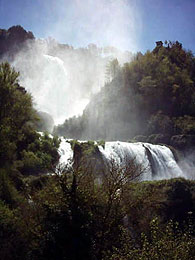


All the structures

Terni’s image is linked to its cultural treasures, scenic beauty and industrial wealth. Terni is known for its metal and steel industries, but also for its churches: S. Francesco (which retains its frescoed Paradisi Chapel from the 15th century), S. Salvatore, and the Sanctuary of S. Valentino. The most famous is S. Valentino, the patron saint of lovers who was also bishop of Terni.
The Marmore Waterfall is a natural attraction that symbolizes the city. It was built by the Romans (c. 300 BC) to protect the Rieti plain from frequent floods.
At the entrance to Valnerina stands the town of Narni with its Bridge of Augustus, medieval streets, Piazza dei Priori (where the main building is the Palazzo del Podestà from 1200), cathedral, fully restored fortress and churches. Important among these are S. Mary in Pensole and S. Augustine, but better known is S. Francesco, erected over an oratory founded by the saint himself. Finally, surrounded by countryside, is the Abbey of S. Cassiano.
Do not miss visiting Amelia, said to be the oldest Umbrian town (12 BC). The scene of wars between the Guelphs and Ghibellines, its town walls are still preserved (the oldest part dating back to 6 BC). The Romanesque cathedral was rebuilt in the 17th century. Next to the cathedral stands the 11th century tower.
A jewel in the Terni province is Orvieto, an Etruscan centre that has conserved extensive necropoli. The cathedral (begun in 1290) is of world renown, with its chapel painted firstly by Beato Angelico and Benozzo Gozzoli, then by the Cortona artist Luca Signorelli, (one of his most important works). Descending to a depth of 61.32 m is the S. Patrizio Well, which has two parallel, concentric stairways built around its cylindrical part, one formerly used for going down and one for coming up. Another symbol of the city is the Maurizio Bell.